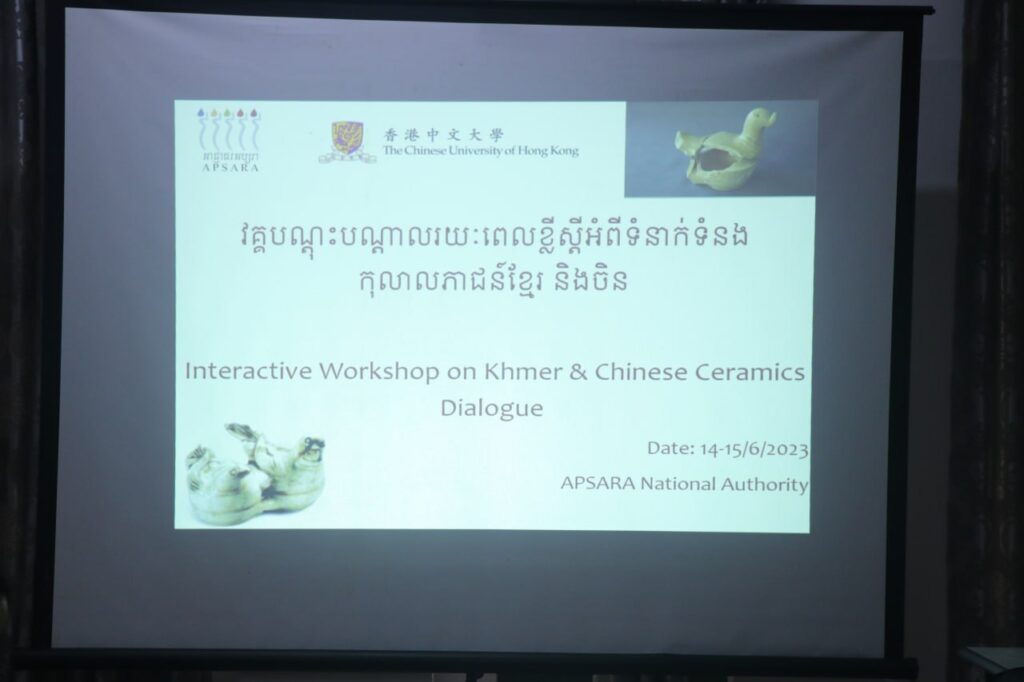ងៃទី១៤ ខែឧសភា ឆ្នាំ២០២៣នេះ អាជ្ញាធរជាតិអប្សរា សហការជាមួយ The Chinese University of Hong Kong បានបើកវគ្គបណ្តុះបណ្តាលស្តីពី កុលាលភាជន៍ខ្មែរ និងកុលាលភាជន៍ចិនដល់បុរាណវិទូរបស់អាជ្ញាធរជាតិអប្សរា នៅមជ្ឈមណ្ឌលបណ្តុះបណ្តាលអាជ្ញាធរជាតិអប្សរា។ គោលបំណងសំខាន់នៃវគ្គបណ្តុះបណ្តាលក្នុងរយៈពេល២ថ្ងៃនេះ គឺផ្តោតសំខាន់លើ៖ ការសិក្សាពីកុលាលភាជន៍ក្នុងវិស័យបុរាណវិទ្យា,ការសិក្សាពីកុលាលភាជន៍ខ្មែរ និងការរកឃើញថ្មីៗ,ការផលិតនិងការប្រើប្រាស់កុលាលភាជន៍ខ្មែរ,កុលាលភាជន៍ចិន និងកុលាលភាជន៍ខ្មែរ,កុលាលភាជន៍ចិន និងអង្គរ,ការរកឃើញកុលាលភាជន៍អាស៊ីនៅក្នុងនាវាដែលលិចក្នុងតំបន់អាស៊ីប៉ាស៊ីហ្វិក។ល។
ក្នុងវគ្គបណ្តុះបណ្តាលនេះដែរ លោកស្រី Sharon Wong Wai-yee តំណាងសាកលវិទ្យាល័យចិនហុងកុងនឹងបង្ហាញពីអត្តសញ្ញាណកុលាលភាជន៍ក្នុងរាជវង្សចិននីមួយៗដល់សិក្ខាកាមដែរ ព្រោះដូចយើងបានដឹងរួចមកហើយ ក្នុងពេលធ្វើកំណាយស្រាវជ្រាវ ឬកំណាយសង្រ្គោះនៅក្នុងតំបន់អង្គរ បុរាណវិទូតែងតែប្រទះឃើញបំណែក ឬកុលាលភាជន៍ខ្មែរ និងចិននៅក្នុងស្រទាប់ដី។ បំណែក ឬកុលាលភាជន៍ដែលរកឃើញទាំងនេះ អាចនាំឱ្យអ្នកស្រាវជ្រាវអាចកំណត់អាយុកាលស្រទាប់ដី ឬរមណីយដ្ឋានបានមួយចំណែកធំដែរ។
សូមបញ្ជាក់ថា អាជ្ញាធរជាតិអប្សរា បានចុះអនុស្សារណៈនៃការយោគយល់គ្នារវាងអាជ្ញាធរជាតិអប្សរា និងសាកលវិទ្យាល័យចិនហុងកុង ដើម្បីសិក្សាស្តីពីឧស្សាហកម្មផលិតកុលាលភាជន៍ខ្មែរនៅសម័យអង្គរ (ពីស.វ.ទី៩ដល់ស.វ.ទី១៤) និងសម័យក្រោយអង្គរ (ស.វ.ទី១៥ដល់ស.វ.ទី១៩) និងទំនាក់ទំនងរវាងអារ្យធម៌ខ្មែរ ជាមួយអារ្យធម៌ចិន៕
អត្ថបទ៖ នាយកដ្ឋានស្រាវជ្រាវ បណ្តុះបណ្តាល និងផ្សព្វផ្សាយ
រូបភាព៖ ភោគ ជា
APSARA National Authority launches an interactive workshop on “Khmer and Chinese Ceramics Dialogue”
On 14 May 2023, the APSARA National Authority in collaboration with the Chinese University of Hong Kong launches an interactive workshop on “Khmer and Chinese Ceramics Dialogue” for archaeologists of the APSARA National Authority at the APSARA National Authority Training Center. The two-day training focuses on: the study of ceramics in archeology, the study of Khmer ceramics and the latest discoveries, and the production and use of Khmer ceramics, Chinese ceramics, Angkor ceramics, the discovery of Asian ceramics in sunken ships in the Asia-Pacific region, etc.
During the training, Ms. Sharon Wong Wai-yee, a Representative of the Chinese University of Hong Kong, will present the identities of each Chinese royal ceramic to the participants, as we already know during the excavation or rescue excavation in Angkor. Archaeologists often find fragments of Khmer and Chinese ceramics in the excavation. The fragments or ceramics found may allow researchers to determine the age of the soil or the site.
It should be noted that the APSARA National Authority signed a Memorandum of Understanding between the APSARA National Authority and the Chinese University of Hong Kong to study the Khmer ceramic industry in the Angkorian period (from the 9th century to the 14th century) and the period after Angkor (15th century to 19th century) and the relationship between Khmer and Chinese civilization.
Article: Department of Research, Training, and Communication
Photos: Phouk Chea
Share:
Our Latest News

អាជ្ញាធរជាតិអប្សរា រៀបចំកម្មវិធីបណ្ដុះគំនិតកុមារចេះថែរក្សាបរិស្ថានក្នុងតំបន់អង្គរ- APSARA National Authority organizes an environmental training program for children in the Angkor site- 29 May 2025
ថ្ងៃទី២៩ ខែឧសភា ឆ្នាំ២០២៥ អង្គភាពប្រព័ន្ធគ្រប់គ្រងបរិស្ថានអង្គរនៃអាជ្ញាធរជាតិអប្សរា សហការជាមួយសាលាបឋមសិក្សាចំនួន៣ មានសាលាបឋមសិក្សាដូនឪ សាលាបឋមសិក្សាត្រពាំងស្វាយ សាលាបឋមសិក្សាគោកគ្រើល ស្ថិតក្នុងស្រុកអង្គរធំ ខេត្តសៀមរាប




